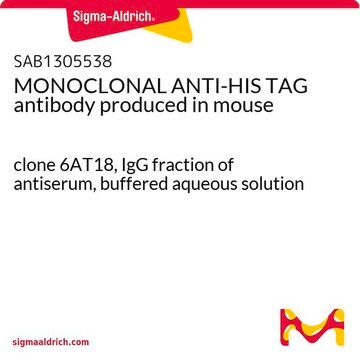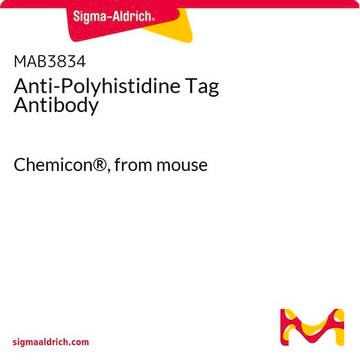The detection limit of product H1029 is 0.5 μg/ml or less.
H1029
Monoklonaler Anti-polyhistidin-Antikörper in Maus hergestellte Antikörper
clone HIS-1, ascites fluid
Synonym(e):
Monoklonaler Anti-polyhistidin-Antikörper, Monoklonales 6-His-Epitop-Tag, Monoklonales 6xHis-Tag, Monoklonales HHHHHH-Epitop-Tag, Monoklonales Hexahistidin-Tag, Monoklonales His-Tag, Monoklonales His6-Tag, Monoklonales Histidin-Tag, Monoklonales Polyhistidin-Tag
Größe auswählen
Größe auswählen
About This Item
Empfohlene Produkte
Biologische Quelle
mouse
Qualitätsniveau
Konjugat
unconjugated
Antikörperform
ascites fluid
Antikörper-Produkttyp
primary antibodies
Klon
HIS-1, monoclonal
Form
liquid
Methode(n)
dot blot: suitable
immunoprecipitation (IP): suitable
indirect ELISA: suitable
western blot: 1:3,000 using lysates of Escherichia coli induced to express a 6xHis tagged protein
Isotyp
IgG2a
Versandbedingung
dry ice
Lagertemp.
−20°C
Posttranslationale Modifikation Target
unmodified
Suchen Sie nach ähnlichen Produkten? Aufrufen Leitfaden zum Produktvergleich
Allgemeine Beschreibung
Spezifität
Immunogen
Anwendung
Biochem./physiol. Wirkung
Physikalische Form
Sonstige Hinweise
Rechtliche Hinweise
Sie haben nicht das passende Produkt gefunden?
Probieren Sie unser Produkt-Auswahlhilfe. aus.
Lagerklassenschlüssel
10 - Combustible liquids
WGK
WGK 1
Hier finden Sie alle aktuellen Versionen:
Analysenzertifikate (COA)
Die passende Version wird nicht angezeigt?
Wenn Sie eine bestimmte Version benötigen, können Sie anhand der Lot- oder Chargennummer nach einem spezifischen Zertifikat suchen.
Besitzen Sie dieses Produkt bereits?
In der Dokumentenbibliothek finden Sie die Dokumentation zu den Produkten, die Sie kürzlich erworben haben.
Kunden haben sich ebenfalls angesehen
-
What is the detection limit of Product H1029, Monoclonal Anti-polyHistidine antibody?
1 answer-
Helpful?
-
-
Is Product H1029, Monoclonal Anti-polyHistidine antibody, suitable for use in immunofluorescence studies?
1 answer-
Product H1029 has been used in immunofluorescence and a good picture of the staining has been published. Ker R. Marshall, et al., Journal of General Virology 83, 1601-1612 (2002).
Helpful?
-
-
How many histidines are required for proper recognition by Product H1029, Monoclonal Anti-polyHistidine antibody?
1 answer-
Product H1029, Monoclonal Anti-polyHistidine antibody requires at least 6 histidines in a row for recognition.
Helpful?
-
Active Filters
Unser Team von Wissenschaftlern verfügt über Erfahrung in allen Forschungsbereichen einschließlich Life Science, Materialwissenschaften, chemischer Synthese, Chromatographie, Analytik und vielen mehr..
Setzen Sie sich mit dem technischen Dienst in Verbindung.













